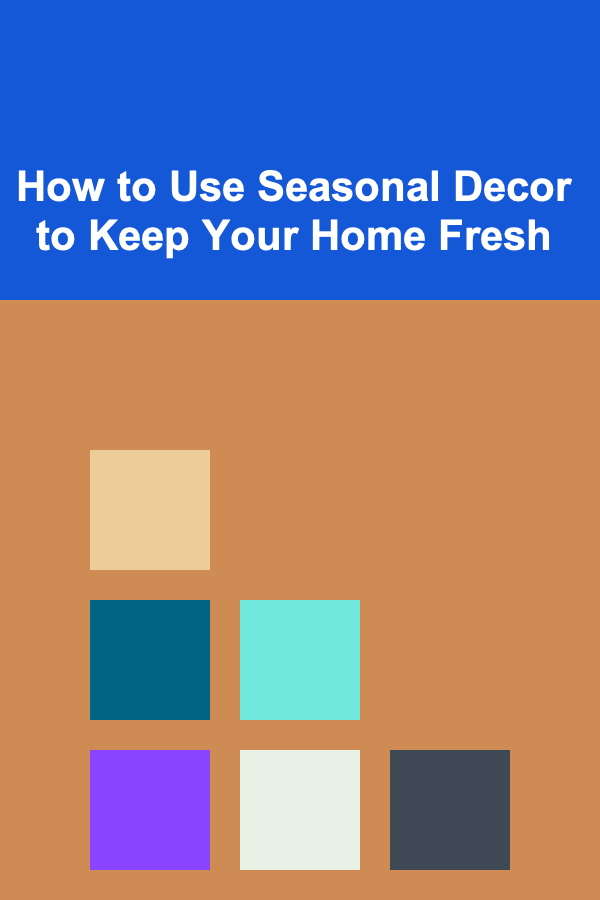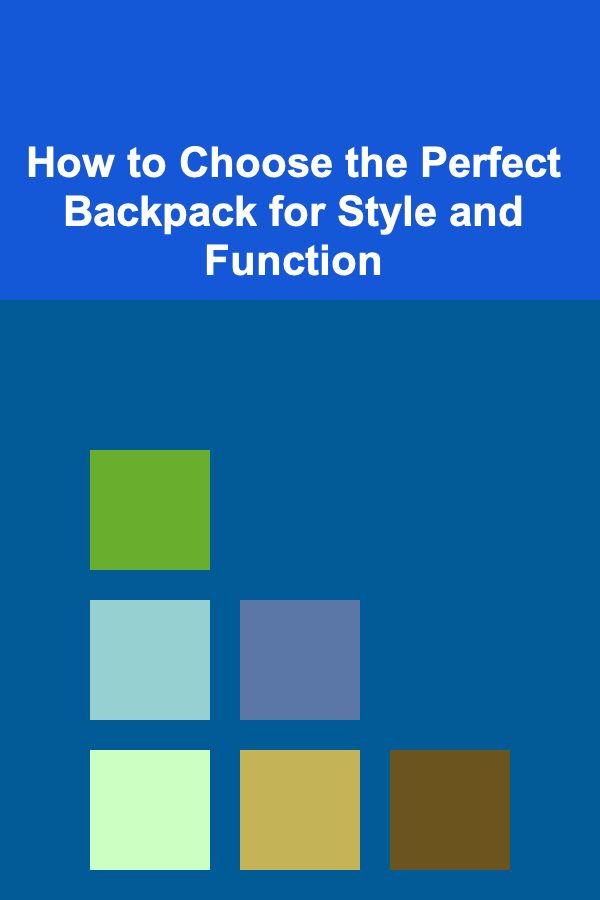
How To Style Shelves and Bookcases Beautifully
ebook include PDF & Audio bundle (Micro Guide)
$12.99$8.99
Limited Time Offer! Order within the next:

Styling shelves and bookcases is one of those home décor tasks that can significantly elevate the aesthetic of any room. Whether you're a minimalist who prefers clean lines and a curated selection of books or someone who loves mixing books with personal artifacts, the way you style your shelves speaks volumes about your taste, personality, and design sensibilities. This guide will help you understand the art of styling bookshelves and shelves, offering practical tips and creative ideas to help you design a stylish and visually appealing display.
The Importance of Styling Shelves and Bookcases
Shelves and bookcases often serve as more than just storage solutions. They can act as decorative focal points, showcasing your interests, passions, and personal style. By styling them well, you can create a balanced, visually interesting display that adds texture, color, and depth to the room. Properly styled shelves can also make your space feel more cohesive, functional, and inviting.
The challenge lies in creating a shelf arrangement that is both aesthetically pleasing and practical. For instance, you don't want to overcrowd a bookcase with too many books or items that overwhelm the eye. Instead, the goal is to curate a display that is organized yet dynamic, elegant yet personal.
Decide on the Purpose of Your Shelves
Before diving into the styling process, it's crucial to understand the purpose of your shelves. Are they meant to store books, display art, or hold functional items? The purpose will dictate the overall arrangement, as different goals require different approaches.
Book Storage
If your primary objective is to store books, you might want to keep the focus on them, using color, height, and alignment to create visual interest. Consider whether you want to organize your books by genre, author, or size, or if you prefer a more eclectic approach where books are arranged in a less predictable fashion.
Displaying Art and Decor
If your shelves are meant to display art, personal objects, or plants, these items can take center stage, with books and other objects serving as a backdrop. This approach emphasizes aesthetics over function, focusing more on creating a curated look than organizing by category.
A Combination of Both
Most often, shelves serve a combination of functions. In this case, the challenge is finding the right balance between storing books and displaying objects. This approach requires a little more thought to ensure the shelves are both functional and visually pleasing.
Organize Your Books
Books are typically the most prominent items on a bookshelf, and their arrangement can set the tone for the entire space. Here are several ways to organize your books:
By Color
One of the most popular trends in styling bookshelves is organizing books by color. This method turns the spines of the books into a cohesive visual element, creating a rainbow-like effect that can be eye-catching and modern. However, this method may make it harder to find specific books, so it's more suited for those who value aesthetics over functionality.
By Size or Height
Grouping books by size can give your bookshelf a more structured and orderly appearance. Taller books can be placed at the back, with smaller ones in front, creating a cascading effect. This is a practical and visually pleasing method, especially when you're incorporating other decorative objects.
By Genre or Author
If you prefer a more traditional approach, you can organize books by genre or author. This is an excellent choice for avid readers who want quick access to their collection while still maintaining a level of visual harmony.
Mixed Arrangement
If you want to break free from traditional methods, consider mixing books with objects in an organic and asymmetrical fashion. This arrangement is ideal for those who enjoy an eclectic look and are willing to experiment with balance and placement.
Add Decorative Objects for Interest
While books are the focal point of most shelves, incorporating decorative objects can add layers of interest, texture, and personality to the display. These can include vases, sculptures, candles, framed photographs, plants, or art pieces. Here's how you can use decorative objects to enhance the look of your shelves:
Use Objects of Varying Height
When adding objects to your shelves, vary their heights to create balance and interest. Place taller objects at the back or center, and smaller items in front or at the edges. This approach ensures that the display feels dynamic and not too flat. Taller objects like vases or sculptures can serve as anchors, drawing the eye to specific areas.
Incorporate Natural Elements
Bringing nature indoors is a timeless way to elevate any space. Plants are particularly effective on shelves, adding a pop of color and a sense of life to the room. Whether it's a hanging plant, a small succulent, or a large leafy fern, plants can soften the rigid lines of a bookshelf and bring a sense of tranquility to the space.
Display Personal Items
Personal items, such as heirlooms, souvenirs, or family photographs, can make a bookshelf feel uniquely yours. These pieces add character and tell a story, allowing you to express your individuality. Just be sure not to overcrowd the shelves---personal items should complement the books, not overwhelm them.
Mix Materials and Textures
To avoid a monotonous look, try mixing different materials and textures. For example, combine wooden objects with glass, ceramic, or metal pieces. A glass vase, metal sculpture, or woven basket can add contrast and visual depth to the shelves, creating a balanced and sophisticated display.
Incorporate Lighting
Lighting can play a huge role in styling shelves and bookcases, enhancing the overall atmosphere of the space. The right lighting not only highlights your carefully selected objects but also creates mood and ambiance.
Under-Shelf Lighting
Install LED strip lights under the shelves to add a soft, ambient glow. These lights will illuminate the shelves, drawing attention to the objects displayed and creating a cozy, inviting atmosphere. This type of lighting works particularly well in a living room, home office, or library.
Accent Lighting
Spotlights or small table lamps placed nearby can also highlight key objects on your shelves. Accent lighting adds warmth and drama, especially in darker rooms. Use adjustable spotlights to focus on specific items like sculptures, artwork, or unique books.
Decorative Lamps
Incorporating decorative lamps on or near shelves can be a stylish way to combine functionality with décor. For example, a statement lamp placed on a shelf can serve as both a source of light and a piece of art, elevating the overall look of the space.
Add Texture with Baskets and Trays
Textured accessories can soften the appearance of a shelf, making it feel more inviting and warm. Baskets and trays are excellent additions to any bookshelf. They can help organize smaller objects, prevent clutter, and add a sense of cohesion to the display.
Baskets
Woven baskets are an easy way to add texture and warmth to your shelves. Use them to store books, magazines, or smaller decorative objects. The natural fibers of a basket provide contrast to the hard lines of books and add an earthy, organic feel to the room.
Trays
Trays are perfect for grouping together smaller decorative items like candles, jewelry boxes, or knick-knacks. A tray helps create a defined space for these objects, preventing them from looking scattered. It's also a great way to display collections in a more organized manner.
Consider Symmetry and Balance
When styling shelves and bookcases, balance is key. Whether you prefer an asymmetrical or symmetrical layout, the arrangement of books and objects should feel harmonious and balanced.
Symmetrical Layouts
For a more formal and orderly look, try arranging your shelves symmetrically. Place items evenly on both sides of the shelf, creating a sense of equilibrium. For example, you can position books in matching pairs or place decorative objects symmetrically on either side of a large item.
Asymmetrical Layouts
If you prefer a more relaxed, casual vibe, opt for an asymmetrical layout. This approach is great for a bohemian or eclectic style, where the goal is to create a dynamic, curated look. An asymmetrical arrangement involves placing objects of varying sizes and heights in a seemingly random fashion, but with careful attention to balance and visual weight.
Keep It Simple and Avoid Overcrowding
While it's tempting to fill every available space on your shelves, less is often more. Overcrowding can make your shelves feel chaotic and overwhelming, and it can detract from the beauty of individual items. When styling your shelves, aim for a balance between functionality and simplicity.
Leave some empty space between objects to allow each item to breathe and make a statement. This will also help create a sense of order, making it easier for your eye to navigate the display.
Regularly Refresh and Update Your Display
Just as your tastes evolve, so too should your bookshelf arrangements. Refreshing your shelves every few months keeps your space feeling new and exciting. Swap out books, change the position of decorative objects, or add new items that reflect your current interests.
Changing the display regularly also allows you to incorporate seasonal décor, such as adding candles and festive items in the winter or fresh flowers in the spring.
Conclusion
Styling shelves and bookcases is a personal and creative endeavor that allows you to showcase your style, personality, and interests. By considering the purpose of the shelves, organizing books thoughtfully, adding decorative objects, incorporating lighting, and maintaining balance, you can create an aesthetically pleasing display that enhances the overall ambiance of any room.
Remember that the key to beautiful shelves is balance---finding the right mix of function and décor. Whether you prefer a minimalist look or a more eclectic arrangement, the important thing is to create a space that feels uniquely yours. Happy styling!
Reading More From Our Other Websites
- [Home Maintenance 101] How to Safely Handle and Maintain Your Home's Gas Appliances
- [Home Staging 101] How to Stage a Bathroom: Creating a Spa-like Atmosphere on a Budget
- [Home Lighting 101] How to Use Lighting to Create a Seamless Flow Between Rooms
- [Organization Tip 101] How to Use Accent Chairs to Balance Furniture Layout
- [Gardening 101] The Best Garden Planters for Small Spaces and Urban Gardens
- [Weaving Tip 101] The Intersection of Weaving and Embroidery: Hybrid Projects for Creative Makers
- [Personal Finance Management 101] How to Cut Back on Unnecessary Subscriptions and Save More
- [Home Holiday Decoration 101] How to Decorate Stairs for the Holidays with DIY LED Garland
- [Trail Running Tip 101] Best Compression Sleeves for Reducing Leg Fatigue on Multi‑Day Trail Events
- [Organization Tip 101] How to Manage Your Time While Pursuing Hobbies

How to Choose the Best Baby Stroller for Your Lifestyle
Read More
How To Understand the Forgetting Curve and How to Beat It
Read More
How to Use Seasonal Decor to Keep Your Home Fresh
Read More
How To Reduce Your Risk of Peripheral Artery Disease
Read More
How to Choose the Perfect Backpack for Style and Function
Read More
10 Tips for Displaying Your Origami Patterns
Read MoreOther Products

How to Choose the Best Baby Stroller for Your Lifestyle
Read More
How To Understand the Forgetting Curve and How to Beat It
Read More
How to Use Seasonal Decor to Keep Your Home Fresh
Read More
How To Reduce Your Risk of Peripheral Artery Disease
Read More
How to Choose the Perfect Backpack for Style and Function
Read More